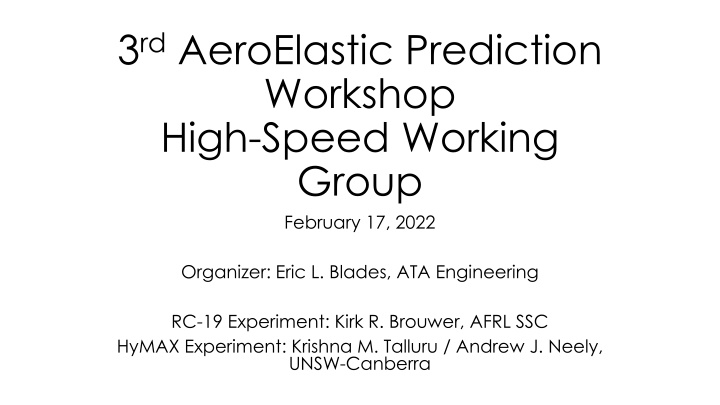
Aeroelastic Prediction Workshop: High-Speed Working Group Updates
Stay informed about the latest progress and updates from the Aeroelastic Prediction Workshop's High-Speed Working Group. Discover details about ongoing experiments, participant confirmations, progress updates, and next steps. Join the collaborative efforts and contribute to the advancements in aerospace engineering.
Download Presentation

Please find below an Image/Link to download the presentation.
The content on the website is provided AS IS for your information and personal use only. It may not be sold, licensed, or shared on other websites without obtaining consent from the author. If you encounter any issues during the download, it is possible that the publisher has removed the file from their server.
You are allowed to download the files provided on this website for personal or commercial use, subject to the condition that they are used lawfully. All files are the property of their respective owners.
The content on the website is provided AS IS for your information and personal use only. It may not be sold, licensed, or shared on other websites without obtaining consent from the author.
E N D
Presentation Transcript
3rdAeroElastic Prediction Workshop High-Speed Working Group February 17, 2022 Organizer: Eric L. Blades, ATA Engineering RC-19 Experiment: Kirk R. Brouwer, AFRL SSC HyMAX Experiment: Krishna M. Talluru / Andrew J. Neely, UNSW-Canberra
Open Agenda Administrative Progress updates and questions Intended to be a working meeting
Administrative Confirm workshop participants and tools plan to use Seeking volunteers to provide progress updates for future meetings
Progress Updates Have sufficient information to generate models and perform simulations? RC-19 HyMAX UNSW can provide CAD geometry file Contact Eric Blades directly for CAD file Suggested to use the 2021 AIAA Journal for reference Has anyone started simulations? Encountered any issues to share with WG? Questions?
Next Steps Details for both experiments available at AePW3 website https://nescacademy.nasa.gov/workshops/AePW3/public/wg/highspeed Monthly telecon slides posted as well Post-processing scripts also provided for to aid comparisons and ensure consistency of results Collective AePW group meetings 1stThursday of each month (currently on bi-monthly schedule) Next meeting is April 7th, 2022 @ 10:00 AM CT Please share with colleagues to increase participation
Questions and Comments
Aravinth from Penn State Univ. working with Dr. Daning Huang. We just started modeling the RC19 problem: 1. Is there presence of any cavity resonance effect? No need to consider the effect 2. What is the time difference between the previous and present states for the data shared? A couple of seconds from one condition to the next SSC did not consider hysteresis effect in their simulations
Displacement amplitude of RC-19 Attached shock case Mean: 1.5 2 panel thickness No wedge Mean value: 0 panel thickness Dynamic response was significantly larger Structural nonlinearities are important
If interested in sharing grids, provide grids to Eric Blades and they will be uploaded to AePW3 website for others to use
Background Information
Aeroelastic Prediction Workshop High Speed Working Group part of larger AePW organization High angle of attack WG Large deflection WG Flight test WG Lead Organizer: Pawel Chwalowski, NASA LaRC The aeroelastic prediction workshop series is intended to provide an open forum, to encourage transparent discussion of results and processes, to promote best practices and collaborations, and to develop analysis guidelines and lessons learned
Objectives Assess state of the art for high-speed FSI predictions Develop guidelines / metrics for: Coupling frequency - characterize degree of non-linear interaction Model fidelity, e.g. panel methods, RANS, HRL Feedback to identify gaps in experiments What needs to be measured in future experiments to get better agreement between test & analysis And vice-versa
Workshop Schedule SciTech 2022: Workshop announcement Monthly meetings to address questions 3rdThursday of each month @ 4:00 PM CT Oct 2022: Participants submit results SciTech 2023: Workshop to review predictions and lessons learned Present papers at subsequent conferences
Workshop Structure Plan is for blind participation Experimental data made available after workshop Publications containing data can be made available Inputs provided to characterize structure, WT, ICs, BCs, etc. Similar to AePW2 and other AePW3 working groups Anticipate participants using multi-fidelity models Allow participants to build own meshes/models Geometries are relatively simple Provide meshing guidelines
Two Experiment Configurations Selected for Workshop Represent two types of structural configurations Metallic skin panel for reusable hypersonic vehicle Control surface Both cases Involve shock boundary-layer interaction Well characterized Mandatory and optional cases for each Neither case involves significant thermal response Fluid physics and dynamic structural response are challenging Incorporate thermal effects in future workshops
Overview of Workshop Cases AFRL/SSC clamped thin panel (Mach 2) No shock impingement: Periodic post-flutter response (baseline) and chaotic post-flutter response (optional) Attached SBLI (4 wedge): periodic response (optional) UNSW HyMAX cantilever plate (Mach 6) 2 degree case is laminar (mandatory) 10 degree case is transitional (optional) Oscillating wedge Challenge case (optional) Prescribed motion of oscillating shock generator from 2 to 10
